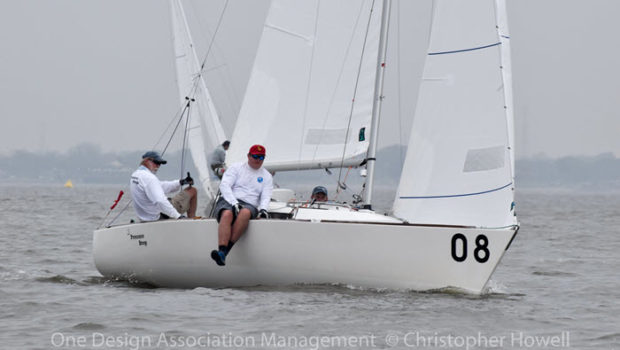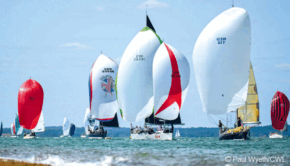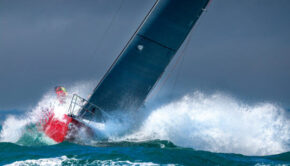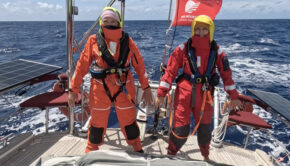Starting line calling procedure
Published on April 10th, 2023
Mark Foster, International Race Officer and US Sailing National Judge, is kind of a big deal. In this report, he shares his tips on providing fair starts:
The following is the procedure I use to call the start of a race.
2 minutes and 30 seconds before the start
Start your recorder (I have started using my phone as my recording device. This allows me to send the file to others who need to hear the recording. It also does a great job of blocking out wind and background noise. I keep it on a lanyard around my neck) and call out the following information:
1) Day, date and start time of the race.
2) Class and race number both of the series and the race of the day.
3) Class and course being sailed.
4) Bearing and length of the leg.
5) Bearing the line is square to and length of the line.
6) Wind strength and direction at that moment.
2 minutes before the start
I call the pin vessel and fleet over the radio to remind them to start their recorder, which flag we are starting under, and if they need to call boats at one minute if we are using a penalty flag. I also tell the pin which over early call plan we will be using. This will have been discussed before and we will have a system we will use on who talks first and how we call numbers out.
1 minute and 30 seconds before the start
I start verbally painting a picture where the boats are, how many are in the box, which end is favored, wind strength and direction. I try to envision what the competitor and jury will need to know to feel confident of the line call.
Once the boats are set up, I start as far down the line I can see and call out numbers, as they are stacked up, for my recorder or the scribe to write down. This allows me to know which boats are in the clumps or just to leeward of a boat which may be over early, or pushing the line.
As the boats get close, I call which boats are sheeting in and who is close. I call out how many boat lengths off the line the closest boats are. As the boats approach the line, I make sure I have a point in the sky, probably a cloud, above the line flag on the pin boat to know where the line is if it gets covered up by boats.
This way I am sure which boats are over early if the line gets covered, which happens as soon as the first boat goes over. This is always the critical question if a boat is seeking redress for being called OCS. The answer that ‘I just knew where the line was’ does not hold water. I pick a feature of a cloud as the point. A cloud will not move very much in the last 10 seconds when you lose sight of the line.
1 minute before the start
For the one minute and start, I have the timer call on the private/back channel radio the time for the flag handlers and so that all line callers will have the time on their recorders. This gives the jury the timing before the start and I am calling out boats that may be over.
This also can support the fact that a boat is over, i.e., “bow 21 is three boat lengths from the line sheeting in 15 seconds to go.” The jury should know speed and distance which can help support the fact bow 21 was over.
Last 10 to 15 seconds before the start
I announce to the flag handler and horn person what I am expecting to call, either Individual or General Recall, so they can be prepared.
As boats go over the line, I record their sail/bow numbers on my phone. I have a procedure that if the flag handler and horn do not hear General Recall, they automatically. after 2 to 4 seconds, raise the Individual Recall and sound one horn with no prompting from me. I do this because I am still busy sighting boats and preparing to announce the numbers.
Then we announce the boats based on the call sequence we have established. Either Pin first or Signal first. If we have a three boat line we set out the call sequence in the morning meeting. Each line sighter knows who will go first.
The procedure for calling boats is using one digit at a time with the word ‘break’ in between, i.e., “one three break two six break,” etc. When they are done, they call ‘break break’ then the next line slighter comes over the radio.
Those numbers are recorded on the Signal Vessel and we announce them one more time on the radio. This procedure keeps the radio clear and you are not trying to step on each other. Note: the last two paragraphs are forgotten if you are starting boats that do not have radios.
If the General Recall was caused by a wind shift or other reason besides the competitors pushing the line, we adjust the line and tell them on the radio what we are doing, and get back into sequence under the P flag. If it was caused by the aggressiveness of the fleet, I announce how many were over and that the next start will be under a penalty flag.
I prefer to go to a U flag for the next start. I do not like to use the I flag or Z flag, because we are here to run races, not practice starts. Plus, using flag I tends to bunch the fleet at either end, and flag Z is tough to accurately record and clear boats. And I over Z is a huge penalty…might as well use flag U at that point.
I have come to realize that no matter what happens with the wind during a race, either shifts or pressure, the same old sunburned faces still show up at the top of the fleet. I feel my job as the PRO is to make sure we have a fair start and all the boats are called correctly. That includes calling everyone over if I can identify the two or three that are behind the line.
As you can tell, a lot happens in the last minute before a start. You need to be prepared for the confusion. Plus if it is windy, you have all the noise of the luffing sails and even the occasional bang as a boat hits the signal boat.
Now a couple of tricks:
• First, keep the AP ready to deploy. If you see the start going sideways because of the wind, you can always AP, adjust, and get going again.
• Second, if you had a penalty flag up as your preparatory flag and you do not take the starting/class flag down at the start, you have made an error in the starting procedure. You have not started the race so you can still AP the race because the starting flag is still up. You will then nullify any penalty flags you had up. I hope you never need this trick.
So stay aware, stay calm, set a square line, have fun, and always remember you are there for the competitors.
Reprinted courtesy of US Sailing Race Management Committee, ussrmcnews@gmail.com.










 We’ll keep your information safe.
We’ll keep your information safe.